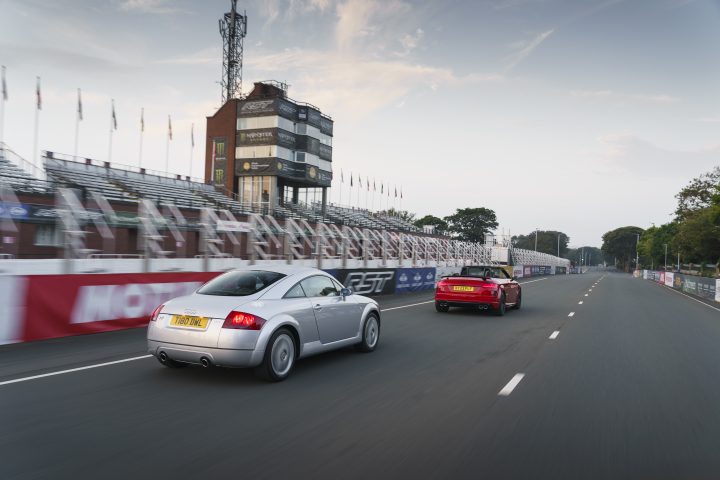The Audi TT – one of the most evocative and transformative models ever to have borne the four rings – celebrates its 25th anniversary in 2023, the year in which production of the Coupé and Roadster models will also draw to a close.
To mark this very significant occasion, Audi UK journeyed to the Isle of Man, whose legendary annual TT race lent the design icon its name, to reflect on its incredible success.

The atmospheric setting also provided the perfect backdrop for the creation of a special collection of images featuring one of the earliest cars alongside two highlight models from the latest range, including the remarkable TT RS Iconic Edition.
“The TT was such a pivotal model for Audi back in the Nineties, and we’re still basking in its afterglow almost three decades after the original concept car became an overnight sensation,” says Director of Audi UK Andrew Doyle.
“It was one of the key catalysts behind the incredible transformation our brand has undergone over the past quarter of a century, and in this special anniversary year its history and legacy richly deserve celebration.”
Crowd pleaser: The TT design study
A rapturous public response to the extraordinary TT Coupé design study unveiled at the Frankfurt Motor Show in 1995 was the touchpaper that helped to spark full-scale series production of that original concept, seemingly with very few outward changes, in 1998.
Conceived by American designer Freeman Thomas, under the then Head of Design Peter Schreyer, the concept car’s minimalist, geometric form evoked the principles of Bauhaus design, a ‘less is more’ philosophy in which every line has a purpose, and every shape a function.
Its purity set it worlds apart from contemporary production models, and it was complemented by an imaginatively designed cabin which carried that geometric theme through into everything from its switchgear and air vents to its many beautiful embellishments in milled aluminium.
Radical even in name
This completely new departure from the familiar hallmarks that defined Audi design wasn’t, of course, the only exception to the rule.
When the wraps came off the concept, AUDI AG was already in the process of bolstering its ongoing transformation with a completely new naming convention for its models in each segment, starting with the successors to its compact executive class 80, executive class 100 and luxury class V8 Saloon, which launched as the A4, A6 and A8 respectively.
Rather than fall into line, though, the Audi coupé and roadster stars-in-waiting instead took their name from one of the oldest motorsport events in the world – the famous Tourist Trophy motorcycle race on the Isle of Man.
More commonly known simply as the ‘TT’, the gruelling road race gave rise to great successes on two wheels for NSU and DKW, brands which were to become intrinsically linked with Audi in its formative years.
In fact, it had also already provided inspiration for the naming of a sporty compact car produced by NSU, the 1965 Prinz 1000 TT.

The same, but different
Unlike many concept cars, which fall victim to practical considerations and are ‘toned down’ in the transition to production, the TT Coupé was lauded at its 1998 launch for reaching the road virtually unchanged.
At first glance, the integration of a rear side window was the only significant difference, ensuring that the road car retained the show-stopping ‘wow factor’ that earned its conceptual ancestor so much international acclaim.
Although there were in fact many other modifications made, not only technically but also in terms of the car’s fundamental proportions, they didn’t detract from that inherent combination of extraordinarily artful design and beautiful detailing.
Underpinned by keen performance, generous equipment and relatively accessible pricing, that remarkable aesthetic appeal ensured that the TT became one of the most sought-after sports cars of its era.
It was, however, far more than simply a sales success – the TT played a crucial role in directing the world’s attention towards Audi, helping to cement public perception of the brand as a design and technology trailblazer and to shore up its ascent to the premium sector position it occupies today.
Suitably keen response and performance in the 1998 Audi TT Coupé, and the convertible TT Roadster which followed it one year later, came courtesy of a transversely mounted 1.8-litre turbocharged four-cylinder petrol engine. Outputs ranged from 150PS to 225PS, driving either the front wheels or all four wheels via an electronically controlled multi-plate clutch-based quattro system.
A 240PS version of the 1.8 T unit was reserved for the particularly prized TT quattro Sport, whose enhanced performance was achieved not only through horsepower gains but also by aerodynamic styling details and weight reduction measures, including the absence of a rear seat.
Its output was exceeded only by the 3.2-litre six-cylinder unit with 250PS, which arrived in 2003 in the TT 3.2 quattro, notable as the first series production Audi model to feature the rapid-shifting twin-clutch automatic transmission known today as S tronic.
Even as far back as the late Nineties, Audi offered its TT customers plenty of scope for personalisation. In addition to colours such as Papaya Orange, Nogaro Blue, Elderberry and Venetian Violet, available as part of the Audi exclusive programme, customers could equip their TT with stunning detail enhancements such as Moccasin-style leather in a ‘baseball glove’ design, which looked sensational in the Roadster show car, and transitioned to series production.
Across its eight-year lifespan, which ended in mid-2006, 178,765 first-generation TT Coupés (Type 8N) rolled off the production line. They were complemented by 90,733 TT Roadsters, which joined the range in 1999 and also bowed out in 2006. In all, 56,469 examples of the first-generation TT in all its forms were delivered to customers in the UK.

Second coming
Playing to the strengths of the celebrated first-generation TT design, while also emphasising an evolutionary leap, obviously presented considerable challenges for the designers of the Mk2 model, launched in 2006.
They held true to the guiding principles of minimalism and purity, retaining the unmistakable silhouette with its strong geometric emphasis, while also incorporating new range hallmarks such as the now familiar Audi Singleframe grille design.
Circular motifs remained unifying elements in the exterior and interior detailing, notably in features such as the aluminium fuel filler cap, the round air vents, the gearshift edging and the distinctive gear knob.
The second-generation TT Coupé, along with the Roadster that followed it in 2007, were based on a new platform shared with the second-generation Audi A3. Its predominantly aluminium body used the Audi Space Frame (ASF) as its foundation, helping to reduce overall weight by as much as 90kg.
It combined front-wheel-drive or quattro all-wheel-drive with 1.8-litre and 2.0-litre turbocharged four-cylinder TFSI engines with 160PS and 200PS, and by a naturally aspirated 3.2-litre V6 with 250PS. In 2008, a 2.0-litre TDI unit also arrived, delivering copious torque that befitted the TT’s character, and staking its claim as the world’s first production sports car to use a diesel engine.
The performance stakes were raised a good deal further in 2008, when the TTS, the first ever ‘S’ version of the TT, channelled 272PS from an uprated 2.0 TFSI unit to the road via quattro drive.
A year later, the high-performance division quattro GmbH, now known as Audi Sport, set another TT performance benchmark with the first TT RS models, which derived 340PS (or 360PS in TT RS plus form) from an extensively updated version of the full-blooded five-cylinder turbo engine whose roots can be traced back to the formidable and famously agile quattro rally cars of the Eighties.
Last but by no means least
The third generation of the Audi TT, launched in 2014 and extensively updated in 2018, again avoided unnecessary divergence from a design that had by this point become well and truly iconic.
The singular style of the original 1998 car is reinterpreted for the modern age in a striking and beautifully proportioned body that deftly combines the hallmark circular TT motifs with more sharply defined lines, while also carrying over familiar details, including the round fuel tank cap.
Weight has been reduced further still – in some cases by as much as 50kg – and onboard technology and connectivity have naturally been greatly enhanced, not least by the addition of the fully digital Audi virtual cockpit, which replaced the analogue dials and MMI monitor and made its Audi range debut in this model.
Over the years power for ‘standard’ third generation TT models has been provided by 1.8-litre and 2.0-litre TFSI engines with outputs ranging from 180PS to 245PS, and by a 2.0-litre TDI with 184PS, the more powerful variants offering the option of quattro drive.
The latest range combines 197PS and 245PS versions of the 2.0 TFSI with S line, Black Edition and particularly amply equipped Final Edition specification levels. A 320PS version of the 2.0 TFSI is reserved for TTS Black Edition and Final Edition models.
Following further painstaking development, the 2.5-litre five-cylinder TFSI slotted into the engine bay of the third generation TT RS Coupe and Roadster with a significantly enhanced 400PS output that made for an even more intoxicating driving experience.
A nine-time category winner of the ‘International Engine of the Year’ award, this irrepressibly punchy and gloriously vocal embodiment of Audi Sport’s incredible motorsport pedigree delivers its final flourish for the TT in the latest TT RS Audi Sport Edition models.
Naturally, it also gives voice to the ultra-exclusive TT RS iconic editions created to celebrate the TT’s milestone anniversary, of which just 11 exist in the UK.
Throughout its colourful life, the TT has been a particular favourite of performance car devotees in the UK, which has consistently ranked as one of its biggest markets.
Overall, across the three generations, and factoring in every variant including S and RS, a total of just over 157,000 examples found homes here.
But the success of these very special members of the Audi family transcends mere sales data – their influence on the brand’s trajectory and reputation can’t be overstated, and rightly categorises them among the most significant, and seminal, models in Audi history.
Audi may be reorienting towards electrification as it pursues its aim of becoming a leading provider of sustainable mobility, but the same passion for progress and innovation that gave rise to the TT remains firmly rooted in its Vorsprung durch Technik ethos.
Thankfully, that means history of the kind made by this particular masterpiece of automotive design looks set to regularly repeat itself.


